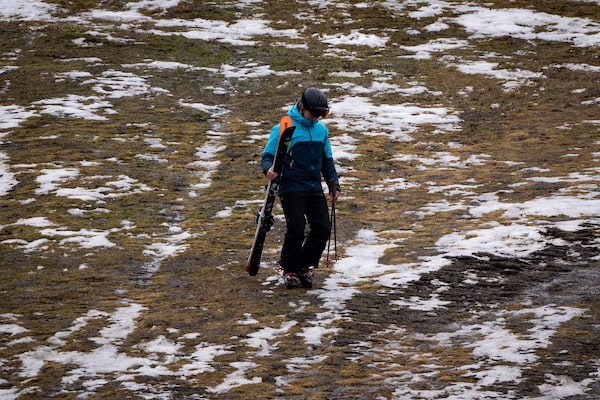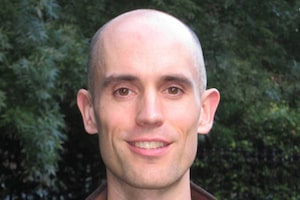
A skier walks down a patchy ski slope at Whistler, B.C., on Dec. 29, 2023.ETHAN CAIRNS/The Canadian Press
Last year, for the first time, the Rideau Canal in Ottawa didn’t open for skating. This year’s season was the second shortest in history, at just 10 days. A lack of snow also upended this year’s ski season across the country. As baseball season kicks into gear, the Toronto Blue Jays will be hoping that wildfire smoke doesn’t force them to close the Rogers Centre roof during games as it did last summer.
The new normal, it turns out, is coming at us very quickly. And for many people, the first tangible signs of climate change are being felt in the sports they play and watch, thanks to heat warnings, wildfire smoke, flooding, disappearing snow and other hazards. It’s an existential threat to sports as we know them – but it’s also, University of Toronto professor Madeleine Orr says, an opportunity.
“People love sports,” says Orr, who is the founder and co-director of the Sport Ecology Group, a consortium of academics who study issues at the intersection of sports and the environment. That makes sports an ideal entry point – ”the spoonful of sugar,” as Orr puts it – to get people engaged in broader discussions about the climate emergency.
What we lose when we lose winter
Orr’s own interest in the topic began with a stint working at a French ski resort in 2015. As a longtime skier who grew up on the slopes around Ottawa and Montreal, she was looking forward to a season in the Alps. But snow didn’t arrive until mid-January, and the poor conditions led to high injury rates and elevated avalanche risk. Orr herself blew out her knee, and five teens were killed in an avalanche on a neighbouring mountain.
University of Toronto professor Madeleine Orr.Selena Phillips-Boyle/Handout
“That just kind of threw everything into focus for me,” Orr recalls. She went on to carve out a research career exploring how climate change is affecting sports and vice versa, a journey she chronicles in a coming book, Warming Up: How Climate Change is Changing Sport, which will be published by Bloomsbury in May.
The book charts the ways sports are already being affected – high-school football players dying of heat stroke, world-championship marathons having to start at midnight to avoid the heat, famous golf courses such as St. Andrews beginning to crumble into the sea – and the various ways that sporting bodies are tackling these challenges.
It also considers the opposite question: how sports are affecting the climate. If you’re a parent whose child keeps having asthma attacks while playing soccer, your first concern is your kid’s health. Maybe game scheduling needs to be rethought; maybe there need to be air quality and weather guidelines that dictate when games are postponed.
Canada’s bird watchers have a front row seat to climate change
Those types of adaptations are just one part of the equation, though. “We want our athletes to be healthy,” Orr says. “But then as soon as that’s done – because that should be easy – then we actually need sports to be part of the solution as well.”
That means rethinking how we participate in sports. Recreational events such as marathons, for example, often involve air travel and produce massive volumes of waste from items such as single-use cups. Runners can make thoughtful decisions about various individual choices such as how often they travel and whether they fly or take ground transportation. They can also focus on durability and sustainability in their gear, Orr suggests. “The longer you can hold on to stuff, the better.”
But there are limits to the impact an individual can have by changing their behaviour in isolation, so a more powerful lever is asking event organizers to make systemic changes. For a marathon, that might mean reducing the amount of landfill-bound trinkets given out by sponsors at the race expo, or adopting Willy Wonka-esque innovations such as bite-sized water capsules in an edible-seaweed membrane to reduce cup use.
A person carries their skates as they walk on the Rideau Canal Skateway in Ottawa after its reopening, on Feb. 18.Justin Tang/The Canadian Press
That same approach applies to the sports we watch. “It’s about being a citizen, not being a consumer,” Orr says. “We can be citizens of the sports world and ask for change, because it’s a health issue, it’s a social issue, it’s an everything issue.”
Many professional sports have already adopted a range of measures such as LED lighting and recycling, which Orr and her colleagues dub Green Sports 1.0. “They’re the gateway drugs to sustainability,” she says, “because those are the things that fans notice.” The sheer scale of big sports events means that seemingly minor improvements such as low-flush toilets can have a substantial impact.
In the wake of the pandemic, during which there was a rise in athlete activism, a more robust form of environmental action emerged. That’s Green Sports 2.0, in which athletes and sports organizations use their public platforms to draw wider attention to climate issues.
Such efforts aren’t without controversy, especially because of what Orr dubs the “hypocrisy trap”: How can athletes call for lower-carbon emissions when they’re traipsing around the globe by jet to play games? It’s not a simple problem to address, because the very premise of professional sport demands frequent travel.
There are no perfect solutions, Orr acknowledges, but there are ways of doing better. Leagues could rethink their schedules to emphasize more regional play and more consecutive games between teams. Trains or buses could replace flights for inter-city travel of less than, say, five hours. And carbon offsets for remaining travel, while imperfect, do make a difference.
Getting these sorts of changes adopted remains an uphill battle, but the stakes are increasingly clear – and, for Orr, personal. This was the first winter she didn’t get a chance to ski. “We’ve pretty much given up on Christmas and Easter skiing, and don’t expect to get much at March break any more,” she says. “But I’m reluctant to give up on it completely.”
Orr hopes her book can spur conversations on the sidelines, in the carpool to the game, or at the dinner table. “I really want moms and dads and teenagers who are into sport and care about climate change to pick it up,” she says, “because that’s who I think are going to raise hell and make this happen.”
 Alex Hutchinson
Alex Hutchinson